Church Floor Artifacts
This article contains information on the Church Floor Artifacts of Venice. For a list of Churches in Venice, see Churches. For information on a typical artifact, see Church Floor Artifact.
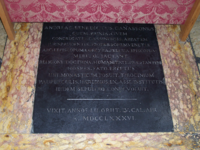 | |
| Churches with Assessed Artifacts | 74 |
|---|---|
| Total Number of Artifacts | 2221 |
| Number of Tombs | 1724 |
| Number of Plaques | 497 |
The artwork in Venetian churches is not limited to sculptures and paintings displayed at eye level on the walls, but many artifacts are found below eye level, in the floors of churches. Venetians used every surface available to decorate all aspects of their lives, including the ground they walked on. In the floors of Venetian churches, several types of artifacts can be found; one of the more common artifacts is a tombstone, marking a Venetian’s final resting place. These markers are left from when burials were still allowed inside city centers and usually contain the individual’s full name, date of birth and date of death. Other information, such as the person’s occupation, can be found on some of the more elaborate pieces. Additionally, plaques are inlayed in church floors which contain information about important events, such as the beginning of construction or prominent contributors. Many of the artifacts in the church floors are carved into tiles, usually marble or limestone, to match the surrounding floor pattern. Different color marbles, such as red, white or black, were used to set the markers apart from the rest of the floor while still keeping a uniform appearance throughout the church.[1]
Churches with Artifacts
The map below shows the churches of Venice, excluding the Lagoon islands, represented as vertical bars, where the height of each church building corresponding to the number of floor artifacts found in its floor. For example, the tallest bar on the graph corresponds to the Church of San Zanipolo (Santi Giovanni e Paolo) in Castello which has 207 church floor artifacts. This church has by far the highest number of artifact. The average church with artifacts only has 30 artifacts. At the other extreme, there are two churches, Church of San Luca and Church of Redentore, that only have one artifact a piece.[2]
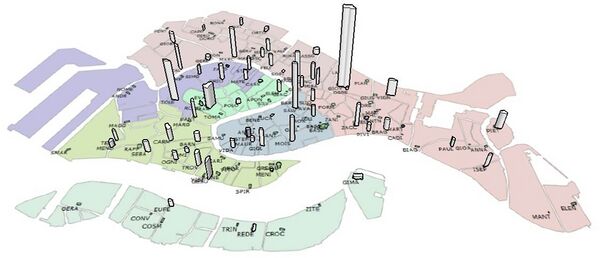
Artifact Descriptions
There are two types of artifacts found in the floors of Venetian churches: tombs and plaques. The difference between tombs and plaques is described on the Church Floor Artifact page. Below are examples of both types of artifacts.[3]
-
Example of a small tomb
-
Example of a plaque
Artifact Preservation
La Soprintendenza is a branch of the Ministry of Heritage and Cultural Activities, an Italian government organization that oversees all restoration efforts involving culturally significant artifacts across Italy. They have isolated four categories of culturally significant artifacts including archives, monuments, works of art and archeology. If a building, monument, or piece of art is in one of these categories, the Soprintendenza dictates all restoration projects that the item may undergo, regardless of if the item is publicly or privately owned. Church floor artifacts are categorized as monuments, and therefore receive preservation funds from the Soprintendenza. Typically, several small projects are carried out each year, such as cleaning a façade or replacing a roof a church, in Venice alone, even though the Soprintendenza is responsible for all of Italy. The majority of their funding comes from tax donations call the octo mille. This donation takes an additional 0.008% of your taxes and applies the money towards restoration projects for various churches across Italy. [4]
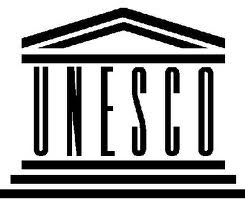
The United Nations Educational, Scientific, and Cultural Organization, UNESCO, is a second platform for providing funding to restore churches. Around the globe, there are nearly twenty private organizations dedicated to funding preservation projects for Venice. Annually, UNESCO sends these organizations the Soprintendenza’s request list to determine which projects they will be funding for the following year. After their decision has been made, they make a donation to UNESCO in order for their desired project to be carried out. UNESCO serves as the middle man, handling the paperwork and observing the logistics of the restoration processes onsite. Worcester Polytechnic Institute project teams have worked tangent to UNESCO to catalog the progress of these restoration projects, and make a record of all the artifacts that lie within the islands of Venice.[5]
Statistical Data
- Need some text here
Church Floor Height
Many churches have been rebuilt or undergone extensive renovations since they were first constructed. A common aspect of renovation was to raise the floor of the church, by either removing the old floor, or building on top of it. It stands to reason that these new floors would contain fewer artifacts, as they have not been in the church for as many years, and therefore would not contain as many artifacts. A weak correlation exists between the elevation of Venetian church floors the number of artifacts contained in them, as evident in the graph below. The red bars correspond to the average artifact damage score of each church, while the blue line represents the floor height of that particular church. You can see as the blue line increases across the graph, the damage to the artifacts per church appears to decrease slightly. Further analysis of when these floors were renovated might provide more insight as to a stronger correlation. [6]
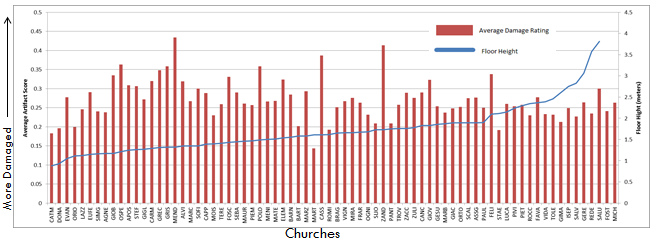
Condition Evaluation
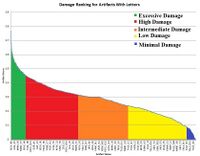
After the artifacts were divided into five categories as described on the Church Floor Artifact page. In the picture to the right, the three middle categories, high damage, intermediate damage and low damage, were determined to be the best candidates for preservation efforts. The two categories on the outside, excessive damage and minimal damage were determined to have either sustained too much damage, or not enough damage, and therefore would not be a productive use of preservation resources. The graph below shows the number of artifacts per church in each of the three middle categories. The red bars correspond to the high damage category, orange to intermediate damage and yellow to low damage.
The taller bars represent churches with a large quantity of damaged artifacts. It is very clear that GIOV, Church of San Zanipolo, has the highest number of artifacts in all three damage categories. Therefore, the floor of this church is a strong candidate for restoration. Additionally, the churches APOS, Church of Santi Apostoli, SALV, Church of San Salvador, SCAL, Church of Gli Scalzi, TOLE, Church of Tolentini, FAVA, Church of La Fava, and MARC, Church of San Marcuola, all have red and yellow columns that are significantly higher than the other churches. These higher bars represent the church floors with many highly damaged artifacts and would benefit from preservation efforts.[7]

In addition to the number of artifacts per church in the high damage category, the percent of artifacts in the high damage category was studied. The results of this are seen in the graph below. This analysis removed some of the bias of the previous figure based on simply the quantity or artifacts in a church, resulting in only the churches with the highest number of total artifacts showing the highest humber of highly damaged artifacts. APOS, Church of Santi Apostoli, CAPP, Church of Le Cappuccine, GREC, Church of Greci, LUCA, Church of San Luca, POLO, Church of San Polo, and REDE, Church of Redentore all have a high percentage of the artifacts in their floors in the high damage category. A high percentage of highly damaged artifacts causes these church floors to be considered a high priority for preservation. Bias does exist in this graph as well, since churches such as Church of San Luca and Church of Redentore both have 100% high damage artifacts but only have one artifact.[8]

Looking at both graphs and comparing the results, the Churches that have the highest need for preservation become evident. The Church of Santi Apostoli emerged as a high priority for both the quantity and percentage of high damage artifacts analysis. Therefore, the Church of Santi Apostoliis a strong candidate for preservation efforts.[9]
Map
There are 74 churches in the city of Venice that have assessed church floor artifacts, six of which are located on the Lagoon islands. Below is a map where one can find the location of the churches with assessed artifacts. The 65 churches that are no located on this map are either churches that are known to no have artifacts, or floors that could not be viewed to know if artifacts are present in their floors. All of these churches can be found on the Churches page.[10]
<display_map height=600 zoom=14 centre=45.440155,12.345403> 45.432596,12.315829|Church of San Nicolo dei Mendicoli 45.433282,12.316219|Church of Le Teresa 45.431996,12.320083|Church of San Sebastiano 45.4453,12.320104|Church of San Giobbe 45.437806,12.321831|Church of Tolentini 45.441437,12.322011|Church of Gli Scalzi 45.433754,12.322091|Church of Carmini 45.43139,12.323435|Church of Ognisanti 45.426919,12.323616|Church of San Eufemia 45.447246,12.323993|Church of Le Cappuccine 45.440825,12.324395|Church of San Simeon Grando 45.432053,12.324449|Church of Le Romite 45.435999,12.32449|Church of San Pantalon 45.442725,12.325268|Church of San Geremia 45.433209,12.325297|Church of San Barnaba 45.436997,12.325308|Church of San Rocco 45.430902,12.325918|Church of San Trovaso 45.438214,12.326034|Church of San Giovanni Evangelista 45.437114,12.326665|Church of Frari 45.429404,12.327164|Church of Gesuati 45.440306,12.327367|Church of San Giacomo dell'Orio 45.441751,12.327774|Church of San Zandegola 45.429983,12.328113|Church of Sant'Agnese 45.443226,12.328588|Church of San Marcuola 45.448149,12.329014|Church of Sant'Alvise 45.432436,12.329398|Church of S. Vidal 45.43721,12.329532|Church of San Polo 45.440238,12.330371|Church of Maria Mater Domini 45.441525,12.330671|Church of San Stae 45.425518,12.330747|Church of San Trinità 45.43372,12.331042|Church of San Stefano 45.433087,12.33157|Church of San Maurizio 45.439702,12.332063|Church of San Cassian 45.443051,12.33218|Church of Santa Fosca in Cannaregio 45.425212,12.332451|Church of Redentore 45.446591,12.332526|Church of La Madonna dell'Orto 45.43274,12.332753|Church of Santa Maria Zobenigo 45.44388,12.33288|Church of San Marziale 45.441723,12.333379|Church of San Felice 45.435839,12.333649|Church of San Luca 45.430179,12.334035|Church of Catecumeni 45.438711,12.334383|Church of San Giovanni Elemosinario 45.43102,12.334754|Church of La Salute 45.441087,12.335001|Church of Santa Sofia 45.424921,12.33516|Church of La Croce 45.438598,12.33531|Church of San Giacometo di Rialto 45.433134,12.336048|Church of San Moisè 45.437731,12.336229|Church of San Bartolomeo 45.43688,12.336506|Church of San Salvador 45.439155,12.337227|Church of San Giovanni Grisostomo 45.437064,12.338003|Church of La Fava 45.437617,12.33846|Church of San Lio 45.440161,12.338539|Church of San Canciano 45.435956,12.338582|Church of San Zulian 45.439566,12.339194|Church of Miracoli 45.443633,12.339254|Church of Gesuiti 45.43959,12.34153|Church of San Zanipolo 45.4414,12.342468|Church of Mendicanti 45.429642,12.342646|Church of San Giorgio 45.438842,12.342818|Church of L'Ospedalletto 45.434724,12.343557|Church of San Zaccaria 45.435571,12.344636|Church of Greci 45.434311,12.344963|Church of La Pietà 45.43621,12.345968|Church of San Giorgio degli Schiavoni 45.434455,12.346797|Church of La Bragora 45.449286,12.346882|Church of San Michele 45.438457,12.347661|Church of La Vigna 45.434662,12.348949|Church of San Martino 45.45502,12.352626|Church of San Pietro Martire 45.432958,12.354037|Church of San Francesco di Paula 45.430633,12.357167|Church of San Giuseppe 45.457527,12.357232|Church of San Donato 45.434805,12.359779|Church of San Pietro di Castello 45.498368,12.418744|Church of Santa Fosca in Torcello </display_map>
See Also
References
- ↑ Dechaine, Danielle, Hennessey, Meghan, Orszulak, Jeffrey, Rullmann, Kevin. Treasures Underfoot: Preserving Venice's Church Floor Artifacts. An Interactive Qualifying Project for Worcester Polytechnic Institute. 2012.
- ↑ Dechaine, Danielle, Hennessey, Meghan, Orszulak, Jeffrey, Rullmann, Kevin. Treasures Underfoot: Preserving Venice's Church Floor Artifacts. An Interactive Qualifying Project for Worcester Polytechnic Institute. 2012.
- ↑ Dechaine, Danielle, Hennessey, Meghan, Orszulak, Jeffrey, Rullmann, Kevin. Treasures Underfoot: Preserving Venice's Church Floor Artifacts. An Interactive Qualifying Project for Worcester Polytechnic Institute. 2012.
- ↑ Soprintendenza B.A.P. di Venezia e Laguna. 2012. 7 Oct 2012 <http://www.soprintendenza.venezia.beniculturali.it/>
- ↑ UNESCO-ROSTE. " Historical Facts: Introductory Notes about the Regional Bureau for Science in Europe Starting from the Disastrous Flooding of 1966 Till Today." , accessed September 8, 2012.
- ↑ Dechaine, Danielle, Hennessey, Meghan, Orszulak, Jeffrey, Rullmann, Kevin. Treasures Underfoot: Preserving Venice's Church Floor Artifacts. An Interactive Qualifying Project for Worcester Polytechnic Institute. 2012.
- ↑ Dechaine, Danielle, Hennessey, Meghan, Orszulak, Jeffrey, Rullmann, Kevin. Treasures Underfoot: Preserving Venice's Church Floor Artifacts. An Interactive Qualifying Project for Worcester Polytechnic Institute. 2012.
- ↑ Dechaine, Danielle, Hennessey, Meghan, Orszulak, Jeffrey, Rullmann, Kevin. Treasures Underfoot: Preserving Venice's Church Floor Artifacts. An Interactive Qualifying Project for Worcester Polytechnic Institute. 2012.
- ↑ Dechaine, Danielle, Hennessey, Meghan, Orszulak, Jeffrey, Rullmann, Kevin. Treasures Underfoot: Preserving Venice's Church Floor Artifacts. An Interactive Qualifying Project for Worcester Polytechnic Institute. 2012.
- ↑ Dechaine, Danielle, Hennessey, Meghan, Orszulak, Jeffrey, Rullmann, Kevin. Treasures Underfoot: Preserving Venice's Church Floor Artifacts. An Interactive Qualifying Project for Worcester Polytechnic Institute. 2012.
Bibliography
Dechaine, Danielle, Hennessey, Meghan, Orszulak, Jeffrey, Rullmann, Kevin. Treasures Underfoot: Preserving Venice's Church Floor Artifacts. An Interactive Qualifying Project for Worcester Polytechnic Institute. 2012.
Gagnon, Davidm Thompson, Kelly, Ruscitti, Eric. Embedded Heritage: A Study of Venetian Church Floors. An Interactive Qualifying Project for Worcester Polytechnic Institute. 2005.
S. Hoey, M. Kahan, P Marchetti, K Mazza. Convents, Palaces and Churches: Transformation of Historic Buildings and the Impact on Venice’s Neighborhoods. An Interactive Qualifying Project for Worcester Polytechnic Institute. 2003.
Santos,Luiz G., Petrowski,Craig Peter, Kristant,Elaine Hazel, Delaive,Amanda Leigh. The Church Floors in Venice, Italy -- an Archeological Study and Analysis. An Interactive Qualifying Project for Worcester Polytechnic Institute. 2002.
Soprintendenza B.A.P. di Venezia e Laguna. 2012. 7 Oct 2012 <http://www.soprintendenza.venezia.beniculturali.it/>
UNESCO-ROSTE. " Historical Facts: Introductory Notes about the Regional Bureau for Science in Europe Starting from the Disastrous Flooding of 1966 Till Today." , accessed September 8, 2012.
External Links
http://en.wikipedia.org/wiki/Chorus_Association

